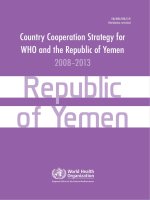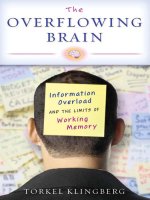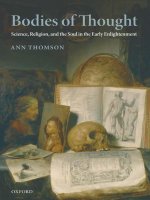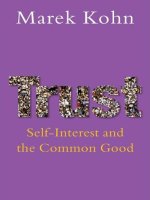- Trang chủ >>
- Khoa Học Tự Nhiên >>
- Vật lý
trust self-interest and the common good sep 2008
Bạn đang xem bản rút gọn của tài liệu. Xem và tải ngay bản đầy đủ của tài liệu tại đây (1.59 MB, 161 trang )
—TRUST—
SELF-INTEREST AND
THE COMMON GOOD
EEE
This page intentionally left blank
Trust
SELF-INTEREST AND
THE COMMON GOOD
E
Marek Kohn
1
3
Great Clarendon Street, Oxford ox2 6dp
Oxford University Press is a department of the University of Oxford.
It furthers the University’s objective of excellence in research, scholarship,
and education by publishing worldwide in
Oxford New York
Auckland Cape Town Dar es Salaam Hong Kong Karachi
Kuala Lumpur Madrid Melbourne Mexico City Nairobi
New Delhi Shanghai Taipei Toronto
With offices in
Argentina Austria Brazil Chile Czech Republic France Greece
Guatemala Hungary Italy Japan Poland Portugal Singapore
South Korea Switzerland Thailand Turkey Ukr aine Vietnam
Oxford is a registered trademark of Oxford University Press
in the UK and in certain other countries
Published in the United States
by Oxford University Press Inc., New Yor k
© Marek Kohn 2008
The moral rights of the author have been asserted
Database right Oxford University Press (maker)
First published 2008
All rights reserved. No part of this publication may be reproduced,
stored in a retrieval system, or transmitted, in any form or by any means,
without the prior permission in writing of Oxford University Press,
or as expressly permitted by law, or under terms agreed with the appropriate
reprographics rights organization. Enquiries concerning reproduction
outside the scope of the above should be sent to the Rights Department,
Oxford University Press, at the address above
You must not circulate this book in any other binding or cover
and you must impose the same condition on any acquirer
British Library Cataloguing in Publication Data
Data available
Library of Congress Cataloging in Publication Data
Data available
ISBN 978–0–19–921791–5
10987654321
Typeset by SPI Publisher Services, Pondicherry, India
Printed in Great Britain
on acid-free paper by
Biddles Ltd., King’s Lynn, Norfolk
CONTENTS
Preface – vii
chapter 1
Just Going Round to the Shop – 1
chapter 2
Trust from the Barrel of a Gun – 23
chapter 3
Reason to Believe – 40
chapter 4
In God We Trust – 58
chapter 5
Through Thick and Thin – 75
chapter 6
The Goodwill of the People – 98
chapter 7
Leaving the Door Unlocked – 118
Notes – 134
Further Reading – 139
Bibliography – 140
Index – 147
This page intentionally left blank
PREFACE
Now that agreement has been reached about how humankind
can best make a profitable living, with a sing le economic
orthodoxy established around the world, an increasing num-
ber of scholars and commentators have turned their attention
to the question of how people can live well. Recognizing that
beyond a certain level of material security, mone y delivers
diminishing returns, they reflect on what really makes life
rewarding, and what makes a society good, rather than merely
prosperous. They write about qualities like community, status,
respect, and happiness. Trust is one of these qualities. Like its
companions, it is fundamental to a fulfilling life and a good
society.
This short book is intended as a contribution to the growing
discussion about these precious, and elusive, qualities of life.
It is not a survey of the literature in the academic sense, nor a
pocket textbook, nor even a primer, but an essay that responds
to a rich array of knowledge and ideas. I have been intrigued,
challenged, and inspired by what I have read in researching it: I
have written it in a way that I hope will evoke similar responses
from its readers.
It starts with individuals and moves on to nations. The
terrain is sketched out in Chapter 1 with an everyday scene that
illustrates the main personal and public dimensions of trust.
This opens up an introductor y discussion about what trust is,
viii preface
what it feels like, and what conditions are required for it to
develop.
The argument then re-starts in Chapter 2 from first prin-
ciples, asking how cooperation can evolve among organisms
or other agents pursuing their individual interests. Discussing
some of the answers to this question that have been obtained
by the application of game theory, it describes a remarkable
example of real-life games played by soldiers across enemy
lines in the First World War. Chapter 3 also beg ins with
evolutionary theory, considering the problem of how signals
produced by self-interested organisms can be reliable, and
ends with a philosophical discussion of whether trust can be
rational.
In Chapter 4 the relationship between authority and trust
is examined, describing the course taken from traditional
authority to modernity. Starting with a discussion of trust in
gods, the account goes on to examine how people have sought
to invest their trust as the power of religious faith and asso-
ciated traditions has diminished. Although trust is extensive
in the experts who create the systems through which much of
modern life is lived, it is far from perfect, and is compromised
by undercurrents of distrust in institutions.
Chapter 5 then considers trust in society, or its absence, the
effect of low social trust on economic development, and the
idea of social capital. It reflects on the polarization of trust
between mutually antagonistic communities, each warming
itself by the flames of its hostility to the other, and on trust
in districts shared by members of diverse groups. The rela-
tionship between social tr ust and people’s trust in political
preface ix
institutions is discussed in Chapter 6. Communist totalitari-
anism relied on distrust, and devoted much of its energy to
orchestrating it among its subjects. Liberal democracy is also
based on distrust, but in the opposite direction: it is founded
upon the suspicion that the powerful will be tempted to abuse
their power, and so must be subject to checks and balances.
Among its citizens distrust is endemic, but only to the point
of complacency.
This theme is concluded in Chapter 7, which points out
some of the weaknesses of the idea of generalized trust, while
affirming that it expresses a quality that is fundamentally
important to a good society. The chapter and the book then
end with reflections on the place of trust in a world that is
in constant flux, spinning ever faster, compulsively initiating,
revising, rearranging, and discarding its relationships.
E
I am most grateful to Latha Menon for commissioning and
editing this book; to Charles Lauder Jr, Eva Nyika, and James
Thompson for helping to realize it; to Andrew Brown, Chris-
tine DeBlase, Gavin Keulks, David Skinner, and John Street
for advice and assistance of various kinds; and to three anony-
mous readers for their very helpful comments on the original
proposal.
This page intentionally left blank
1
JUST GOING ROUND TO THE SHOP
T
he kitchen is in full steam; pans hiss and spoons
clatter, plates are slapped onto trays and sauces mar-
shalled; the parent animating all these objects leans
across and opens the breadbin—which, being empty, stops the
cavalcade in its tracks. She steps out to reach for her coat, then
pauses again; instead, she calls to summon her child, causing
a hiatus in another sphere of activity, whose clattering, mar-
shalling, and animating constitute the equally busy domain of
play. She hands him some coins and sends him out, down the
street and across the road to the shops. Within a few minutes
he returns, carrying a loaf; behind in the shop he has left
the payment and a recorded video image of himself. In this
brief and everyday episode, the two of them have negotiated
or touched upon most of the basic dimensions of trust.
Two transactions have taken place: the one between parent
and child, the second between child and merchant. The sec-
ond belongs to the class that has preoccupied many theorists
of trust, those whose vision is set in the marketplace, and
who conceive of trust primarily as an issue that arises between
individuals idealized as rational, free, and equal. Starting here,
within the home and the family, we get our priorities in order.
2 just going round to the shop
Trust begins, or should begin, between parent and child; it is
upon the basis of trust thus established that individuals can go
out to become actors in a marketplace. And starting here, w ith
a child offering a coin to a shopkeeper, we set off aware that for
most of the transactions of everyday life, trust must inhere in
relationships between agents who are significantly unequal in
power, resources, or autonomy.
1
Before the child sets off out of the door, there must be trust
between him and his mother. On his part, this is based on the
unconditional and total trust that arises—unless suppressed
by neglect or gross distortion of parental roles—as a founding
condition of childhood. He is old enough to be able to disagree
with a parent about the details of where his interests lie, but
his sense of his place in the world rests upon his absolute
confidence that his parents have his fundamental interests at
heart. He is sure that his mother would not send him into a
world in which he would be in peril. More than either of them
are consciously aware, his sense of basic security is created and
sustained by the routines of life: the Saturday breakfast, more
relaxed than on weekdays, with its menu compiled by the fam-
ily’s various members, the iterated children’s games that put a
familiar cast of characters—plush, plastic, or pixels—through
variations upon a basic repertoire of parades and adventures.
All these affirm that the world may be treated as if it were
constant, reliable and secure.
That goes for his mother too. Her everyday decisions must
be based on a sense of normality; that the world is constant
enough for its risks to be intuitively assessable. She must feel
a basic safeness underneath the inevitable risks; she must feel
just going round to the shop 3
some degree of basic trust in people whom she does not know
personally or at all.
She must also trust her child, in two successive respects.
First she must be sure of his competence to do what she asks
of him. He must be old enough to be capable of the task. If
so, he is also old enough to be left in the house while she runs
the errand herself. Indeed that’s her initial impulse, and would
probably be simpler, but she has strategic considerations to
weigh. He needs to learn how to go out and act in the world;
she must learn to trust him to do so. She must enable him to
become trustworthy.
Once she trusts in his competence, she must trust him to
apply that competence in her interests. She trusts him not
only to collect the change but to return it to her in full; she
trusts him to buy what she has specified rather than what he
might prefer. Her faith in him may be augmented by norms
that he has absorbed, from school or other public sources as
well as his parents, encouraging him to pick up a brown loaf
instead of a sugar-laced white one or a carton of doughnuts.
His choice is underwritten by his keenness to do what she
wants him to do; her interests are thus incorporated in his.
She must also trust him not to trust. Her watchword will
be ‘Take care crossing the road, and don’t talk to strangers.’
Distrust of strangers is regarded as a precondition of inde-
pendent ventures into public space; and even road safety
involves awareness that relates to trust. At the crossing the
child must remember that cars may not always stop when
the lights change. When he looks up at the security camera
overlooking the till—or the street—he will see a reminder
4 just going round to the shop
that public spaces contain untrustworthy people. And these
include children. The shopkeeper is prepared to trust him
on his own, but would not if he came in with a few of his
friends—‘No more than four schoolchildren at a time’ is the
quota stipulated on the door.
Nevertheless, these anxieties rest upon a thick carpet of
trust. All concerned trust that the traffic lights will not sud-
denly malfunction and send vehicles off into collisions. The
shopkeeper and the customers trust that the till calculator
will reckon the bills correctly and that the banks will record
the resulting changes in balances accurately. They trust the
money; which is to say that the y trust the immense and mys-
terious network of systems and institutions that guarantee the
banknotes’ promises to pay their bearers what they say they
are worth. This implies that whatever complaints they may
have about the government, they have a basic confidence in
the functioning of the state and the economy. Impersonal-
ity seems to promote trust in many contemporary contexts.
The customers will ignore the automatic camera, but if they
saw the shopkeeper photograph the child himself, they would
probably call the police.
We can recognize this as a distinctively contemporary
cameo not just because of the presence of a security camera,
but because it is infused with a sensitivity to risk that would
seem neurotic to earlier generations. Contemporary analyses
of trust emphasize its intimate connection with risk, and some
go so far as to depict trust as a specifically modern phenom-
enon arising from a pre occupation with risk that has arisen as
this particular phase of history has developed. Trust does not
just going round to the shop 5
arise when tradition dictates each person’s place and how they
shall conduct themselves in it. When your actions are deter-
mined by your station in society, your gender, your parents,
their parents, and their parents before them, all implement-
ing a universally accepted, pitilessly enforced body of rules
that prescribe your actions in any situation you are likely to
encounter, then what’s to trust?
The answer is that life is never so ordered or choices so
forced that the need for trustworthiness can be eliminated.
A society may be segmented by rank and bound by codes
of honour, yet allow Machiavellian individuals to flourish—
not least Niccolò Machiavelli himself, in Renaissance Florence.
In any society there will always be scope among peers, such
as friends, siblings, or trading partners for choices about the
extent to wh ich one takes another’s interests into considera-
tion. That would have been the case when people all gathered
or hunted their food, rather than growing or buying it. Ques-
tions of trustworthiness arose as humans became human, if
not before.
That is not to deny a distinctive character to modern rela-
tionships, and the questions of trust that arise in them, how-
ever.Theydiffer from traditional ones in number and dura-
tion. Throughout human prehistory, most of history, and
large areas of today’s world, people have generally tended to
interact with small numbers of other people over extended
periods of time. For the most part they would spend their time
with people of their own small group, and their contact with
outsiders would be limited. In the modern world the reverse is
becomingly increasingly true. People range fur ther, in person
6 just going round to the shop
or via e lectronic networks, and frequently have encounters
with people they never meet again. Their circles of acquain-
tance are continually being updated.
At the same time, the numbers in the inner family circle
have fallen. Perhaps the child sent to the shop has siblings; per-
haps they’re out with their father; but there’ll only be a few of
them compared with the traditional chorus. This, rather than
bureaucratic angst, is what sets the terms for contemporary
assessments of risk. Large parts of the world are now reliable
enough to permit people to have very few children, and to
concentrate on them enough to enable them to take advantage
of the opportunities that the world now presents. People no
longer accept that they should have many children and expect
to bury one or two of them; they need to believe that the few
children they have will grow up safely to live lives that should
be long, healthy, comfortable, and rich in experience. The risks
both of loss in an absolute sense and of lost opportunities
are unconscionable, and per iodically fray the fabric of public
trust.
Often what picks it apart is food. Buying a loaf requires
implicit trust in the systems that ensure the safety of food.
It need not be absolute trust: a parent who prefers a brown
loaf to a white one may also be bothered about the addition
of various chemicals to the bread. But it is sufficient until
the food in question becomes the focus of a health scare, at
which point ambient trust may be replaced by incandescent
suspicion. Blame will then find its way to the government, as
inevitably as water flows downhill, highlighting the mistrust of
political institutions that helps to define the modern political
just going round to the shop 7
condition. Much of the attention devoted to trust in public
discourse revo lves around the public’s suspension of belief in
political theatre. This may, however, be a problem for politi-
cians rather than for democracy, whose structural foundations
are actually based on mistrust. Liberal states take as given that
those with power will be tempted to abuse it, so the powers
of the state are separated into divisions intended to check and
balance their exercise.
Negotiations between presidents, premiers, parliaments,
and courts are relatively clear, from the public’s point of view,
if remote. Alarms about health and safet y are more disturb-
ing, because they raise questions not only about governments
and bureaucrats but about the expert systems on which mod-
ern life depends. Wrangles in the upper strata of power, for
instance between a government and the judiciary, appear usu-
ally to be over values rather than facts. Health scares throw
facts into question. They raise doubts about networks that
are even less comprehensible than the money system, involv-
ing industrial processes and scientific investigations into the
effects of substances or pathogens. The public would like to
see these systems as disinterested and reliable, like bank trans-
actions or air traffic control, but is uneasily aware that experts
differ, science proceeds by debate, and commercial and polit-
ical interests are inevitably at work. When public alarms arise
in specifically medical contexts, where people feel that their
lives are in professionals’ hands, mistrust may rapidly flare
into a sense of betrayal.
The child has come back from the shop with a loaf and a
trail of actual and potential issues of trust. They begin with
8 just going round to the shop
the original trust between parent and child; they resolve into
questions of competence and commitment; they include a
background of trust in expert systems; they touch upon anxi-
eties about malevolence and dishonesty in public spaces; they
point to the volatilit y of public trust in certain institutions.
The scene works as a three-hander—parent, child, trader—
but in doing so poses questions about the rest of the cast. The
other parent could be round the corner, or could be anywhere.
Others with varying degrees of significance could be part of
the family network. Families and intimate relationships are
short of certainties and full of possibilities these days, their
variet y of forms creating a new variety of demands for trust.
Making sense of trust requires deciding what t rust is. Many
theorists have devoted themselves to this task over the past
two or three decades, and have arrived at many different con-
clusions. Instead of trying to resolve their differences, it may
be helpful to reflect briefly upon the community of meanings
labelled ‘trust’; to inquire whether its various senses are close
kin, tightly bound factions or passing acquaintances. At this
stage description and definition may be equally useful.
We might begin with an attempt to specify the formal terms
of a trusting relationship: A trusts B to do X. Envisaging
trust as a relation between two particular parties, concern-
ing a particular action or range of actions, this formulation
(by Russell Hardin) will define trust for the purposes of this
book.
2
But instead we’ll start with what trust feels like. Even
the word has the gift of warming the heart and dissolving
its tensions. Very few other words have that power. ‘Grace’ is
one, but remains available only to those who have retained
just going round to the shop 9
the necessary religious faith. The other is ‘love’, which is often
related to trust, and akin to it in quality.
Like love, trust is involuntary. You can’t help whether you
love or trust someone; you either do or you don’t. Although
situations may arise where one says, ‘I’ll just have to trust you
then’, that is not really trust. Rather it means ‘I’ll just have to
take the chance that you will act in my interests,’ or ‘I will have
to act in the same way that I would if I really trusted you.’
These reserved declarations, however, may be steps on the
way to trust. Sometimes one says, ‘I’ll just have to tr ust you’
ironically: it is an opportunity to acknowledge that A already
trusts B, though it may not have been explicit up to that
point. In other circumstances ‘I’ll just have to trust you’ is
an invitation to prove yourself trustwor thy. These subtexts are
initiatives undertaken in the hope of establishing or deepen-
ing trust. Although you can’t make yourself trust, you can
act in ways that help trust develop; as is also the case with
love.
Involuntary feelings are often passionate ones, and that
is true for certain celebrated forms of trust, such as those
between lovers or comrades. Trust may be unconditional
too—but rarely so outside the special relationships between
parents and young children. Normally trust is conditional and
limited. It is a practical attitude rather than a transcendent
passion. At the same time it is also, of course, optimistic. Trust
is an expectation, or a disposition to expect, that another party
will act in one’s interests.
It could be termed confidence, or reliance, as in the Oxford
English Dictionar y’s first definition of trust: ‘confidence in or
reliance on some quality or attribute of a person or thing, or
10 just going round to the shop
the truth of a statement’. Some theorists distinguish between
trust and confidence, reserving trust for agents with intentions
and confidence for things or processes. ‘I do not trust the sun
to rise each day, at least not in any meaningful sense beyond
merely having great confidence that it will do so,’ observes
Russell Hardin; who is also careful to distinguish between
trust and trustworthiness, the latter being what is indicated
by qualities and attributes.
3
But although some might find
it wanting in precision, the OED’s definition is not at odds
with the view that trust is an expectation about the actions of
others. Its last part serves as a reminder that of all the actions
that trust is concerned with, few are more critical than the act
of telling the truth.
When we expect others to act in our interests, we do not
expect them to act against their own interests. As Russell
Hardin proposes in his ‘encapsulated interest’ model of t rust,
we must believe that their interests incorporate ours.
4
When a
parent sends a child on an errand to buy a loaf, the coincidence
of interest is all but total. Both are concerned before all else
with the safety of the child; both want to obtain the loaf, which
they will both consume. The potential conflicts of interest are
marginal and matters of interpretation: the child might prefer
not to bother, or might prefer the tastier white bread over the
healthier brown, but his mother will readily make the case for
why doing as she asks is good for his health and character.
Negotiations such as these will help to embed her preferences
within his.
We can be sure about trust and the intertwining of interests
in this case because we can be in no doubt that there is a
just going round to the shop 11
relationship between the parent and the child. There may well
be relationships between each of them and the shopkeeper
too: he is likely to know his local customers at least by sight;
he may enjoy his day-to-day encounters with them; and he
will certainly consider that it is in his commercial interests
to keep their custom. If the relationships between trader and
customers remain healthy, the latter’s interests will be at the
heart of the former’s.
Out in the street, however, interactions are usually too
brief to be described as relationships. Road sense must be
based around a precautionary principle of mistrust. The child
must learn that signals and actions do not always correspond:
occasionally a car will go through a red light, and cars turn
without signalling all the time. But people frequently seem
to cite driving as a striking example of trust in strangers. We
are impressed at our readiness to take our chances among
columns of massive steel projectiles, each controlled by a mind
of its own. It is true that driver A’s interests incorporate driver
B’s to the extent that each wants to avoid colliding with the
other. They do not normally know each other, however; they
may not communicate with each other, and in most cases are
only peripherally aware of each other’s presence. If one consid-
ers that trust involves particular expectations about particular
agents, drivers don’t trust each other. Their trust is placed
in the technical systems that control the flow of traffic; their
confidence is built by the range of punishments that traf-
fic systems threaten against drivers who break the rules; and
they usually assess the risks of driving as acceptably remote.
In some circumstances some drivers may be deterred from
12 just going round to the shop
making journeys because they consider that either roads or
drivers are likely to be more dangerous than usual: in fog or
on Saturday nights, for example. But these are essentially per-
ceptions about how other drivers balance their own interests,
between the urge to arrive quickly and the risk of not arriving
at all, when their judgement is tested by poor visibility or
impaired by alcohol. Under those conditions driver A is even
less aware of driver B than usual.
Although trust may require a meaningful relationship to
satisfy its more demanding analysts, it need not require good-
will. When A is a person and B is a bank, A may trust B
to keep her money safe although she does not imagine for
a moment that the bank feels warmly disposed to her, and
she may well suspect that it will assert its interests at her
expense when it gets a chance to levy charges or manipulate
interest rates. If A enters hospital and is examined by Doctor
B, she may trust B’s professional expertise and integrity even
though B appears indifferent to her as a person. Until rela-
tively recently indifference on the part of medical profession-
als, or plain rudeness, was if anything regarded as a sign of
trustworthiness: it implied the objectivity needed for exper-
tise, and asserted the superior status that medical expertise
conferred.
Trust can even be achieved between parties who are at war
with each other. On the Western Front in the First World War,
where armies were stopped up in immobile trenched lines for
years, units facing each other negotiated covert truces. These
were covert because they had to be concealed from the high
commands on each side, and they were often negotiated by
just going round to the shop 13
gunfire. Artillery shells would be fired into empty ground or at
regular times; riflemen would shoot high or wide. Observing
such sig nals a soldier could come to believe that the man
facing him across the lines ‘ain’t a bad feller’.
5
Soldiers came to
trust their opposite numbers not to attack them unless forced
to do so by senior commanders. These informal arrangements
(of which more later) were possible when units faced each
other long enough for relationships to develop, even though
these were relationships based on exchanges of fire.
Elsewhere in the Great War, trust in enemy soldiers was
officially organized. One former prisoner of war later recalled
how his German captors permitted officers to leave their
camps on ‘honour walks’, having signed forms stating that
they would not try to escape. On their return the officers
would hand in the forms—and would be released from their
undertaking.
6
Between these two examples we can see the
old order passing and a new modern order being born. The
First World War dealt traditional codes of military honour a
blow from which they never recovered: the imprisoned officers
whose word was sufficient to underwrite their privileges were
among the last to enjoy such benefits. In the trenches, the
rank and file had to work out for themselves how to create
trust under modern conditions. They had marched to war in
a state of patriotic enthusiasm that approached ecstasy; and
found themselves in an unprecedented situation that differed
radically from what they had been told they were entering.
They set aside jingoism, propaganda, and unquestioning obe-
dience in order to respond to conditions as they found them.
The modern world made a mockery of traditional authority.
14 just going round to the shop
Presenting new and unpredictable situations at every turn, it
demanded pragmatism and negotiation case by case.
Already it is clear that we can speak of trust in a great
variety of circumstances, and with varying degrees of convic-
tion. Trust that is part of intimate and loving relationships—
parents and children, partners who are also good companions,
confidants, close friends—feels like the real thing. So in its
very different way does the kind of trust that takes imper-
sonal systems—banks or airline operations—for granted. It
is related to a more diffuse confidence in the trustworthi-
ness of people and other agents that are encountered in the
course of normal life, such as shop assistants or passers-
by from whom one asks directions. At a further remove
stand the kind of expressions of trust, or distrust, elicited
by opinion surveys probing people’s attitudes to organiza-
tions or their personnel, such as the police, doctors, or politi-
cians. Then there are the colloquial usages, in which one
might speak of trusting other drivers or ‘having to trust’
someone, that fall short of a firm purchase on trust’s core
meanings.
Those core meanings themselves become harder to grasp
the more one tries to specify what degree of freedom makes
trust possible. It is easy enough to agree that the word ‘trust’
is applicable in situations where the trusted party has some
choice over whether to behave as the truster expects, and that
it lacks conviction in the absence of such choice. A slave-
owner in the Americas might have been completely confident
that his slaves would act in his interests, but that confidence
would be based on control. For many authors, the meaning









